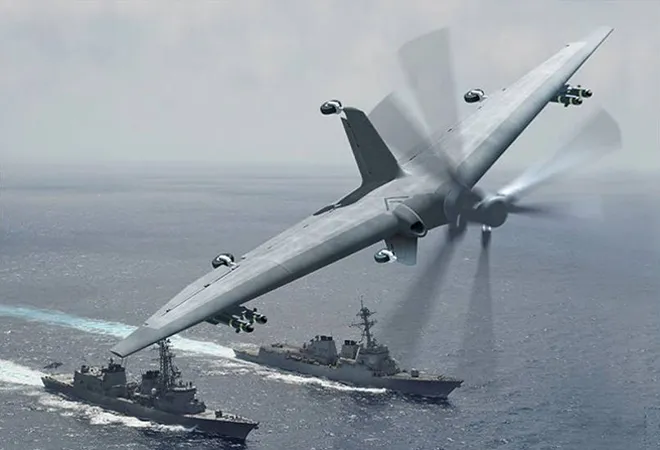
The concept of maritime security, it is often said, is so conditioned by the complexities of the present, that it almost overlooks the vagaries of the future. As the Indian Navy celebrates its 48st anniversary today — a tribute to the sacrifices and accomplishments during the 1971 war with Pakistan — naval planners would do well to reflect on the evolving nature of maritime challenges, to assess the trajectory of future naval operations in Asia. In recent years, New Delhi has invested considerable resources in acquiring high-grade capabilities, including air, subsurface and space assets. As its combat prowess has grown, so has the Navy’s operational mandate, with maritime managers having to prioritise a host of military, diplomatic, constabulary and benign missions.
Yet policymakers and planners today navigate an increasingly uncertain strategic landscape, with threats taking on complex forms, and lines between traditional and irregular challenges progressively blurring. On the one hand, the demand for human security (relief ops, counter-piracy, anti-trafficking, counter-illegal fishing) has rapidly expanded, with naval operations increasingly geared to meet non-traditional threats in the neighbourhood. On the other, maritime planners also have to contend with China’s growing naval footprint in South Asia — a development that has created fears in New Delhi of a shrinking sphere of influence in the Indian Ocean.
Policymakers and planners today navigate an increasingly uncertain strategic landscape, with threats taking on complex forms, and lines between traditional and irregular challenges progressively blurring.
In discussing potential scenarios, India’s maritime planners must then consider five different kinds of soft and hard-power missions, most likely to draw resources and operational effort.
Joint humanitarian operations
The experience of the last decade makes it clear that humanitarian aid and disaster relief (HADR) will constitute the bulk of future maritime missions. In recent years, India has provided human assistance across a vast maritime swath, ning the Indian Ocean Region and the Western Pacific. From relief operations during the Indian Ocean Tsunami (2001), Cyclone Nargis (2008), Cyclone Hudhud (2014), and Cyclone Mora (2017), to civilian evacuations from Libya (2011) and Yemen (2015), the Navy’s record of service has been immaculate. Yet, the scale and intensity of future HADR missions could overwhelm naval commanders, who might find themselves increasingly reliant on contributions from civilian humanitarian agencies and regional partners. As resources get scarce, the Navy will need a collaborative framework of humanitarian operations. Beyond purpose-built hospital ships and modular medical services, the Navy will need networks and associates in crisis scenarios.
‘Distributed’ littoral operations
Twenty first century naval operations are likely to be centered on sustained operations and precision effects in the littorals. In the race to dominate contested spaces, maritime forces would seek to harness high technology, inducting autonomous vehicles, augmented reality systems and advanced wireless networks. Unlike open-sea operations — where strategic action plays an important role — future combat missions would follow a ‘distributed operations’ template for tactical impact in the littorals. Land-attack and precision strike would be key capabilities, but even ‘mine warfare’ is likely to be crucial. The Indian Navy will need modern mine-hunting and mine-laying assets for future high-end conflicts.
Twenty first century naval operations are likely to be centered on sustained operations and precision effects in the littorals. In the race to dominate contested spaces, maritime forces would seek to harness high technology, inducting autonomous vehicles, augmented reality systems and advanced wireless networks.
Submarine operations
In the new era, submarine operations are likely to be dynamic and complex. Future submarines are likely to be deployed in ‘stand-off’ mode — at a safe distance from enemy defences, playing ‘mother-ship’ to an army of unmanned undersea drones. The Asia Pacific, already witnessing a proliferation of diesel-electric submarines, might witness the induction of bigger, stealthier subs. For the Indian Navy, grappling with a sudden expansion of PLAN submarine activity in the Indian Ocean, an ‘undersea rejuvenation’ is a strategic imperative. New Delhi’s signal imperative is to expedite the Project-75 India programme. Beyond numbers, however, the Navy will also need modern ‘quieting’ systems on its submarines, anti-submarine surveillance (advanced sonar) and other warfare technologies for coercive operations in the littorals.
Autonomous vehicle operations
In recent years, unmanned aerial vehicle (UAVs) technology has enhanced naval combat effectiveness in the commons. Future multi-mission UAVs are likely to operate at extended ranges, and conduct long-range penetrating electro-magnetic operations against threats in the air, on land, at sea, and in cyberspace. Meanwhile, the use of subsurface unmanned systems has rapidly expanded. In 2016, the Chinese navy seized a US navy underwater drone vehicle operating in the South China Sea, leading to a brief diplomatic standoff. While China’s actions were widely criticised, the incident demonstrated the growing ubiquity of underwater surveillance assets in littoral spaces, even if coastal states find such activity objectionable. Experts say future ‘sea bots’ could be operated by artificial intelligence and could perform such diverse tasks as reconnaissance, mine placement, and ‘self-destruction’ attacks. With China, Russia and the United States moving to induct unmanned platforms, India too must intensify its quest for high endurance undersea drones.
Rapid-response ‘expeditionary’ missions
China’s recent strengthening of its Marine Corps has prompted many Asia-Pacific states, including Malaysia, Indonesia, Japan and Philippines, to raise their own marine forces. Not only is the PLA’s Marine Corps undergoing an expansion of assets and personnel, it is being readied as a ‘rapid-response’ expeditionary force to project Chinese power around the globe. China’s new amphibious units are able to launch air-cushion landing craft, assault vehicles and helicopters, and can be used for ‘joint missions.’ More crucially, PLA marines are being trained for amphibious raids and ‘island-capture’ in the Western Pacific. In contrast, the Indian Navy is yet to acquire the sealift, mobility and firepower that would constitute a credible ‘rapid-response’ capability in the littorals.
Networked and space operations
Navies today operate in a network centric environment where maritime operations are integrated. Since August 2013, when India launched the GSAT-7, its first dedicated military satellite, the Indian Navy has had an exclusive communication channel. With its 2000 nautical miles footprint over the Indian Ocean Region (IOR), GSAT -7 has helped the Navy network its warships, submarines and aircraft with ground based assets. The launch this month of the GSAT-7A, an advanced communications satellite for the Indian Air Force (IAF), will add to India’s strategic communication and domain awareness capabilities. What the Navy now needs is an operations doctrine, technical standards and a logistical support plan that would enable multi-service networked operations, linking long range missiles, radars and defence systems on all sea and air-based assets.
The Indian Navy’s effectiveness as a net-security provider will depend, in large measure, on its leadership’s ability to plan for complex future challenges. While the Navy has been gearing up, maritime managers don’t yet seem ready for the vicissitudes of future-day operations. What is plainly clear is that the Indian Navy will need strong partnerships in Indo-Pacific. With all the high-technology assets at hand, Indian naval commanders will still need help in securing the littorals.
The views expressed above belong to the author(s). ORF research and analyses now available on Telegram! Click here to access our curated content — blogs, longforms and interviews.




 PREV
PREV


